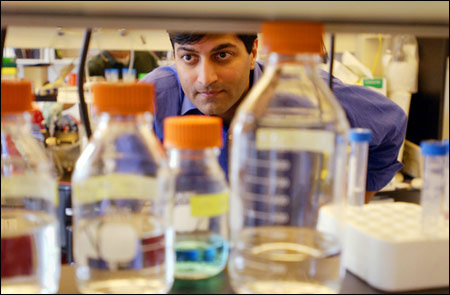Identifying which tumors will spread:
Genes reveal an ominous pattern

The spreading of cancer from one part of the body to another has always been thought of as unpredictable, pure bad luck that causes more deaths than the original tumor.
Researchers at Harvard Medical School are now challenging this idea. They have identified a pattern of gene activity that seems to predict whether cancer will return after it is first treated.
The ominous pattern shows up in many common types of cancer, including lung, breast, prostate, and brain. What’s more, it may be detectable before the malignancy starts to spread.

It’s too soon to call the finding a revolution, but “it has the potential to help us predict which tumors will or will not spread in individual patients,” says Sridhar Ramaswamy, one of the researchers. “Further down the research pathway, it could pave the way to drugs that control spreading.”
Ramaswamy and his colleagues at the Dana-Farber Cancer Institute and the Whitehead/Massachusetts Institute of Technology Center for Genome Research compared the activity of genes in original, or primary, tumors with the activity in those that spread. They found a distinct pattern present in the latter but not the former. Out of 76 patients whose tumors were examined, 12 who showed the spreading fingerprint fared worse than the others.
The researchers then checked about 60 lung cancers and found that people without the gene pattern survived longer than those with it. They also discovered that this signature can predict the spreading of breast, prostate, and brain tumors.
As many as 30 percent of women with early-stage breast cancer have a microscopic form of spreading, too small to be detected. Their primary tumors are removed by surgery, and they often receive drugs to prevent growth of any smaller tumors. Years later, however, many of these women discover their cancer has spread. “We hope the signature we found can lead to a genetic test that will identify these people early enough to provide more aggressive treatment to those who need it,” Ramaswamy notes. Such a test would also spare women without the signature the side effects of drugs they are not likely to need.

Controversial but promising
The research team is now examining some 150 more tumors to further test the association between cancers and gene activity. “We believe that our finding is robust,” Ramaswamy comments. “But since we looked only at a relatively small number of tumors, we want to develop higher confidence in what we observed.”
When the group published its discovery in a scientific journal earlier this year, its report triggered a lot of controversy. “Many experts still view metastasis [spreading] as a random process, dependent more on luck than anything else,” Ramaswamy admits. “So we must study a large number of tumors to be sure what we see is really a general property.”
Once that’s established, the information could be turned into a test that can tell whether a person has a tumor that is likely to spread. It might involve taking a small sample of the tumor with a needle and putting it on a so-called gene chip. The chip is programmed to light up to show which genes are active. The procedure might be as simple as a blood test, or it might turn out to be more complicated.
Such a test would be very helpful to older men diagnosed with prostate cancer. If their tumors grow slowly, they may die with the malignancy instead of from it, eliminating the need for surgery or radiation, which can have drastic side effects. On the other hand, aggressive tumors should be treated immediately.
In the best scenario, one signature may reveal a common pattern of spreading in prostate as well as a number of other tumors – lung, breast, and colon, for example. “It’s an attractive idea,” Ramaswamy says. “But it will take years of work to prove.”
Bad luck, good luck
How did the team come to challenge the dogma that the spread of cancer is just plain bad luck, the result of random gene mutations? “It was a combination of luck and asking the right questions,” Ramaswamy answers. The questions involved odd bits of evidence that didn’t fit the “bad luck” dogma. The luck came in doing the right series of experiments to find a fingerprint that can distinguish a stable primary tumor from one that will spread aggressively.
At first, the investigators identified 128 culprit genes. Further investigation revealed that the pattern can reveal itself in the activity of only 17 genes. That could change as research progresses, but Ramaswamy believes the number will be manageable enough to test large numbers of people.
More than 100 different types of tumors exist. So far, all solid tumors, which occur in lungs, breasts, prostates, brains, colons, and ovaries, fit the fingerprint. But it doesn’t occur in lymphomas, cancers of the lymph glands and spleen. “However, we feel like we’re going in the right direction,” Ramaswamy says. “We are hoping that, in the near future, we will have a good handle on how general our findings are.”
A close look at the solid tumors raises the intriguing possibility that the gene pattern seems to arise from different compartments of the tumors. In other words, not all the activity comes from malignant cells; nonmalignant cells in blood and connective tissues may play a part in the spreading process.
“The activity we are picking up may include cross talk between malignant and nonmalignant cells,” Ramaswamy notes. This situation occurs in a well-known process wherein malignant cells send out chemical signals that cause new blood vessels to form and carry nutrients and oxygen to the tumor. Muting such cross talk can shrink a tumor into harmlessness, experiments with cancer patients have shown.
“We are also looking at the proteins produced by the signature genes,” Ramaswamy says. “If we can find exactly what each gene is doing, then we have taken a step toward developing drugs that might interfere with, perhaps stop, a tumor from spreading.”




